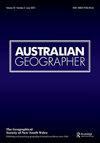地区复兴?2019冠状病毒病疫情下国内移民的地理变化
IF 2
2区 社会学
Q2 GEOGRAPHY
引用次数: 13
摘要
自2019冠状病毒病大流行开始以来,人们一直对城市居民向偏远地区迁移以逃避封锁和行动限制感兴趣,但澳大利亚“地区复兴”的证据仍然是轶事。本文旨在量化2019冠状病毒病大流行在澳大利亚城市和地区的移民水平、模式和驱动因素方面的当前和未来动态。结果显示,与前一年相比,2020年大首都城市统计区域之间的移民率下降了7%,区域地区创纪录的净增长是由城市迁出人口减少9%而非迁入人口增加推动的。我们的预测表明,在2022年之后,各地区的净收益将放缓,但由于入境人数持续增加,新南威尔士州、昆士兰州、南澳大利亚州和塔斯马尼亚州的净收益仍高于大流行前的水平。西澳大利亚地区和北领地将继续录得净损失,而维多利亚州地区的净收益预计将低于2019冠状病毒病前,因为离开人数增加。这些模式对人口预测和有关吸引和留住澳大利亚各区域内部移徙者的政策具有重要影响。本文章由计算机程序翻译,如有差异,请以英文原文为准。
A regional renaissance? The shifting geography of internal migration under COVID-19
ABSTRACT Since the beginning of the COVID-19 pandemic there has been interest in the migration of city-dwellers to regional areas to escape lockdowns and movement restrictions, yet evidence of a ‘regional renaissance’ in Australia remains anecdotal. This paper aims to quantify the current and future dynamics of the COVID-19 pandemic on the levels, patterns and drivers of migration to and from Australian cities and regions. Results show a 7% drop in the rate of migration between Greater Capital City Statistical Areas in 2020 compared to the previous year, with record net gains in regional areas facilitated by a 9% decrease in departures rather than an increase in arrivals from cities. Our forecasts suggest that net gains to regions will slow down after 2022, but remain higher than pre-pandemic levels in New South Wales, Queensland, South Australia, and Tasmania because of a sustained increase in arrivals. Regional Western Australia and the Northern Territory will continue to record net losses, while net gains to regional Victoria are predicted to be lower than pre-COVID-19 because of an increase in departures. These patterns have important implications for population projections and policies regarding the attraction and retention of internal migrants to Australia's regions.
求助全文
通过发布文献求助,成功后即可免费获取论文全文。
去求助
来源期刊

Australian Geographer
GEOGRAPHY-
CiteScore
4.10
自引率
8.30%
发文量
33
期刊介绍:
Australian Geographer was founded in 1928 and is the nation"s oldest geographical journal. It is a high standard, refereed general geography journal covering all aspects of the discipline, both human and physical. While papers concerning any aspect of geography are considered for publication, the journal focuses primarily on two areas of research: •Australia and its world region, including developments, issues and policies in Australia, the western Pacific, the Indian Ocean, Asia and Antarctica. •Environmental studies, particularly the biophysical environment and human interaction with it.
 求助内容:
求助内容: 应助结果提醒方式:
应助结果提醒方式:


